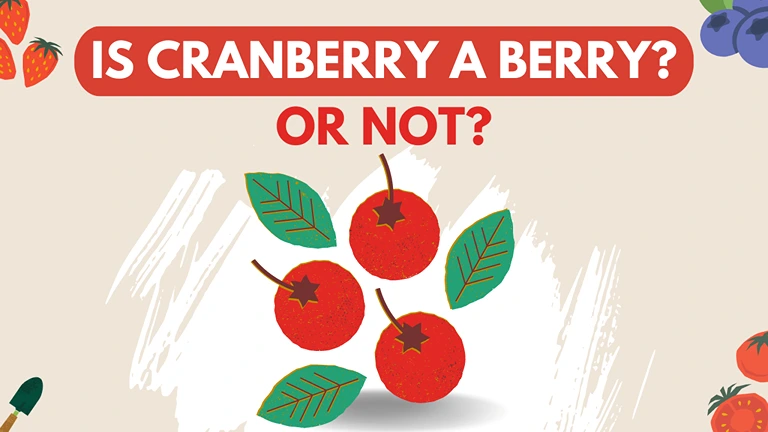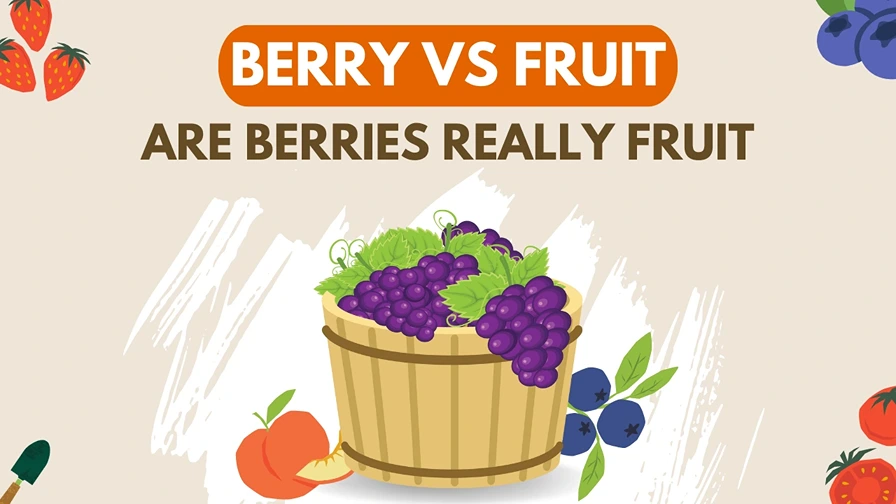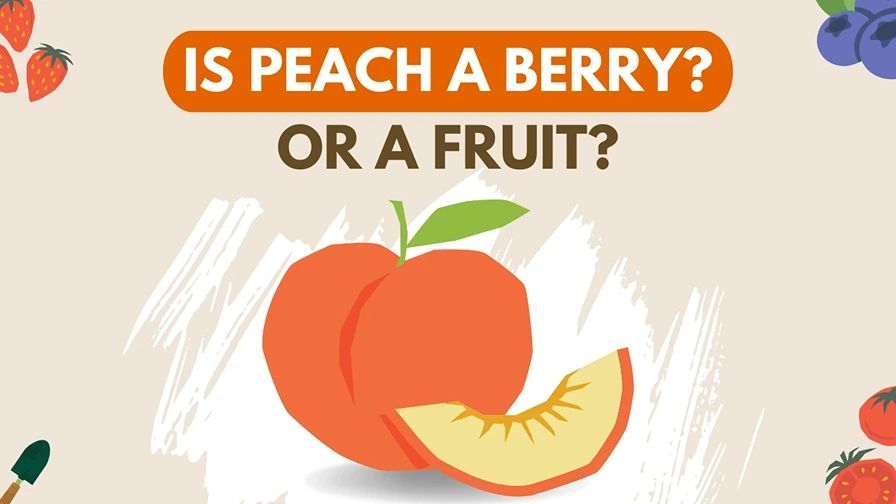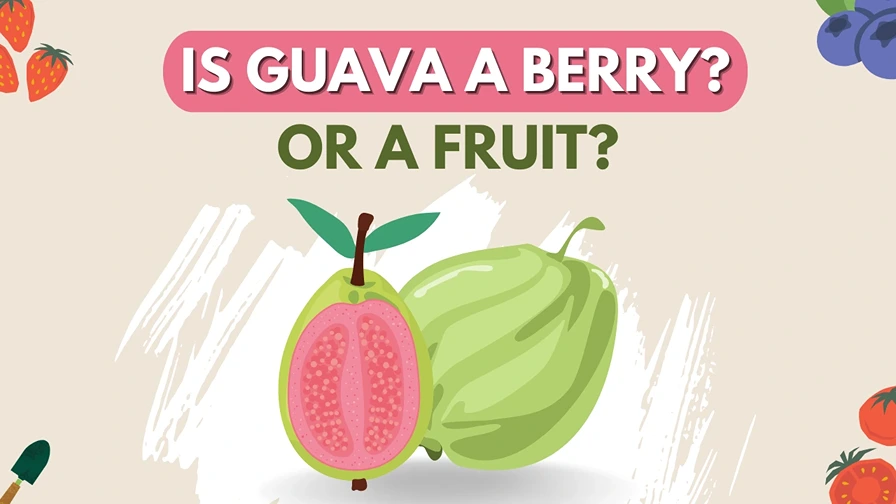When it comes to cranberries, there is often a debate swirling around their classification. Is Cranberry a berry? or something else entirely? It’s a question that has piqued the curiosity of many,
Yes, Cranberry is classified as a true berry.
But why Cranberry is classified as a berry and why it is not classified as another fruit?
In this article, we will delve into the intriguing world of berries and fruits and define cranberries to unravel the mystery.

What is a Berry?
A berry, in botanical terms, is a type of fruit that develops from a single ovary of a flower. It is characterized by having thin skin with fleshy pulp, which surrounds one or more seeds.
Characteristics of a True Berry
To be classified as a true berry, a fruit must possess certain characteristics. Here are the key traits that define a botanical berry:
- Single Ovary: A true berry develops from a single ovary, which is a part of the flower’s female reproductive organ. This means that the entire fruit originates from a single flower.
- Fleshy Pulp: One of the distinguishing features of a berry is its fleshy pulp. This juicy and often sweet part of the fruit surrounds the seeds, providing nourishment and protection.
- Multiple Seeds: Unlike some other fruits, berries typically contain multiple seeds embedded within their fleshy pulp. These seeds are formed from the ovules within the ovary.
Examples of True Berries
To better understand the concept of true berries, let’s take a look at some examples of fruits that fall into this botanical category:
- Blueberries: Blueberries, too, meet the criteria of a true berry. These small, round fruits develop from a single ovary, with a sweet and juicy pulp surrounding several tiny seeds.
- Grapes: Grapes are another example of botanical berries. They grow in clusters, with each grape originating from a single flower and containing multiple seeds.
What is Cranberry?
The cranberry plant, known as Vaccinium macrocarpon, is a low-growing evergreen shrub that belongs to the Ericaceae family. Cranberries are native to North America and have a long history that dates back centuries. Native American tribes were the first to discover the incredible properties of cranberries and incorporate them into their diets.
The cranberry plant features slender, wiry stems that creep along the ground and form dense mats. These mats provide an ideal habitat for cranberries to grow and flourish.
These remarkable fruits thrive in cool, acidic, and waterlogged environments such as bogs and wetlands. The natural habitat of cranberries contributes to their unique growth and flavor.
Characteristics of Cranberry
- Cranberries grow on low-lying vines that are part of the evergreen shrub family. These vines can reach up to 6 feet in length and spread across the ground, forming dense mats.
- Cranberries are small, round fruits that typically measure about 1 centimeter in diameter. They have a slightly flattened shape and are known for their vibrant red color. However, cranberries can also be found in shades of pink, white, and even dark purple.
- When fully ripe, cranberries have a firm texture and a tart taste. Their flavor is refreshingly tangy, which makes them stand out from sweeter berries.
- Cranberries have a unique feature called air pockets. These pockets allow the berries to float in water, which is why cranberries are often harvested by flooding the fields and then gently agitating the vines to release the ripe fruits.
Culinary and Cultural Significance
- Cranberries have been a part of North American culinary traditions for centuries. They are widely used in various dishes, especially during the holiday season. Cranberry sauce, cranberry juice, and dried cranberries are popular additions to many recipes.
- In addition to their culinary uses, cranberries hold cultural significance. They are often associated with Thanksgiving and Christmas, where they are enjoyed as a symbol of abundance and celebration.
Cranberry Fruit Structure
The cranberry fruit is a unique and fascinating specimen to study. Let’s examine its structure and the different parts that make up a cranberry:
- Outer Skin: The outer skin of cranberry is smooth, shiny, and thin, with a vibrant red color when fully ripe. It acts as a protective layer for the fruit, shielding it from external elements.
- Flesh: Beneath the outer skin lies the flesh of the cranberry. Unlike some other fruits, the flesh of a cranberry is relatively firm and tart in taste. It is packed with vitamins and antioxidants, making it a nutritious addition to our diet.
- Seeds: Embedded within the flesh of the cranberry are tiny, pale seeds. These seeds are formed from the ovules within the ovary of the flower. While cranberries typically contain multiple seeds, their size, and abundance may vary from fruit to fruit.
Is Cranberry A Berry?
Now that we have familiarized ourselves with the anatomy of a cranberry, let’s evaluate its characteristics based on the botanical definition of a berry.
- Single Ovary: To meet the criteria of a botanical berry, a fruit must develop from a single ovary. In the case of cranberries, each fruit indeed originates from a single flower’s ovary, satisfying this requirement.
- Thin Skin: Cranberry has a thin outer skin that protects the flesh and seeds inside. This is also similar to the characteristics of berries.
- Fleshy Pulp: Another important characteristic of a true berry is the presence of fleshy pulp that surrounds the seeds. Cranberries possess a juicy, edible pulp that envelops the seeds, contributing to their distinctive flavor and texture.
- Multiple Seeds: While cranberries do contain seeds, their abundance may vary. Some cranberries may have more seeds, while others may have fewer. However, the presence of multiple seeds within the flesh aligns with the botanical definition of a berry.
One notable difference between cranberries and true berries is their structural composition. While cranberries have a relatively firm texture compared to the softness of grapes and blueberries, they still possess the essential characteristics of a berry, including a fleshy pulp and multiple seeds.
Based on our examination of the anatomy of a cranberry, it is evident that cranberries possess several key characteristics of a botanical berry.
Verdict: Is Cranberry a Berry or Not?
Based on our examination of the classification and characteristics of cranberries, it can be concluded that cranberries possess several key traits of a botanical berry. While there may be differences in texture, cranberries meet the criteria to be considered true berries.
Cranberry consists of the pericarp with a thin skin, pulpy flesh, and multiple seeds inside making it botanically a true berry.
Terminology and Colloquial Use of “Berry”
In everyday language, the term “berry” is sometimes used more broadly to refer to fruits that may not fit the botanical definition but share certain similarities. This colloquial use can vary regionally and culturally.
Strawberries, raspberries, and blackberries are commonly referred to as berries in culinary contexts, despite not strictly meeting the botanical definition. Their popularity and culinary versatility have solidified their status as berries in everyday language.
Culinary Use Of Cranberry
Cranberries have established themselves as a staple ingredient in various culinary preparations and beverages. Let’s explore how cranberries are utilized in cooking and beverages:
- Cranberry Sauce: Cranberry sauce is a classic accompaniment to holiday meals and festive celebrations. It is made by cooking cranberries with sugar or other sweeteners to create a sweet-tart sauce that complements savory dishes.
- Cranberry Juice: Cranberry juice is a popular beverage known for its refreshing taste and potential health benefits. It is made by extracting the juice from cranberries and often mixed with sweeteners or blended with other fruits to balance the tartness.
- Dried Cranberries: Dried cranberries, also known as “craisins,” are a convenient and versatile form of cranberries. They are often used as toppings in salads, baked goods, and trail mixes, adding a burst of tartness and sweetness.
- Cranberry-Infused Recipes: Cranberries are also incorporated into various recipes to impart their distinct flavor and vibrant color. They can be found in pies, muffins, cakes, and other baked goods, offering a unique twist to traditional recipes.
Health Benefits of Cranberries
Cranberries are not only versatile and flavorful fruit but also offer numerous health benefits. In this section, we will explore the potential health benefits associated with consuming cranberries.
- Rich Source of Antioxidants: Cranberries are packed with antioxidants, which are beneficial compounds that help protect our cells from damage caused by harmful free radicals. These antioxidants, such as flavonoids and vitamin C, play a vital role in maintaining overall health and well-being.
- Urinary Tract Health: Cranberries have long been recognized for their potential to support urinary tract health. They contain compounds called proanthocyanidins (PACs), which may help prevent certain types of bacteria, like E. coli, from adhering to the walls of the urinary tract. This action can reduce the risk of urinary tract infections (UTIs) and promote urinary health.
- Heart Health Benefits: Regular consumption of cranberries may contribute to heart health. The antioxidants in cranberries, particularly flavonoids, have been associated with a reduced risk of cardiovascular diseases. They may help improve cholesterol levels, reduce blood pressure, and enhance overall heart function.
- Digestive Health: Cranberries are a good source of dietary fiber, which is essential for maintaining a healthy digestive system. Adequate fiber intake promotes regular bowel movements, prevents constipation, and supports a healthy gut microbiome.
- Potential Anti-Inflammatory Effects: Certain compounds found in cranberries, such as anthocyanins, have shown anti-inflammatory properties. These compounds may help reduce inflammation in the body, which is associated with various chronic conditions, including heart disease, arthritis, and certain types of cancer.
- Antimicrobial Properties: Cranberries possess natural antimicrobial properties that may help combat certain types of bacteria and viruses. These properties contribute to their ability to support oral health by reducing the risk of gum disease and preventing bacteria from adhering to teeth.
- Nutrient-Rich Fruit: In addition to the specific health benefits mentioned above, cranberries are also a nutrient-rich fruit. They are low in calories and a good source of vitamins C and E, dietary fiber, manganese, and vitamin K.
Cranberries offer a range of potential health benefits, including their antioxidant properties, support for urinary tract health, contribution to heart health, promotion of digestive health, anti-inflammatory effects, and natural antimicrobial properties. As part of a well-rounded diet, cranberries can be a delicious and nutritious addition that may contribute to overall health and well-being.
Conclusion
While cranberries may not look like a berry due to their relatively firm texture, they possess several key characteristics that align with the botanical criteria. They develop from a single ovary, contain fleshy pulp surrounding the seeds, and often have multiple seeds within the fruit.
So, cranberry is indeed classified as a true berry and has all the characteristics to be a berry.
Furthermore, cranberries offer numerous health benefits. They are rich in antioxidants, support urinary tract health, contribute to heart health, promote digestive health, possess potential anti-inflammatory effects, and exhibit natural antimicrobial properties.




